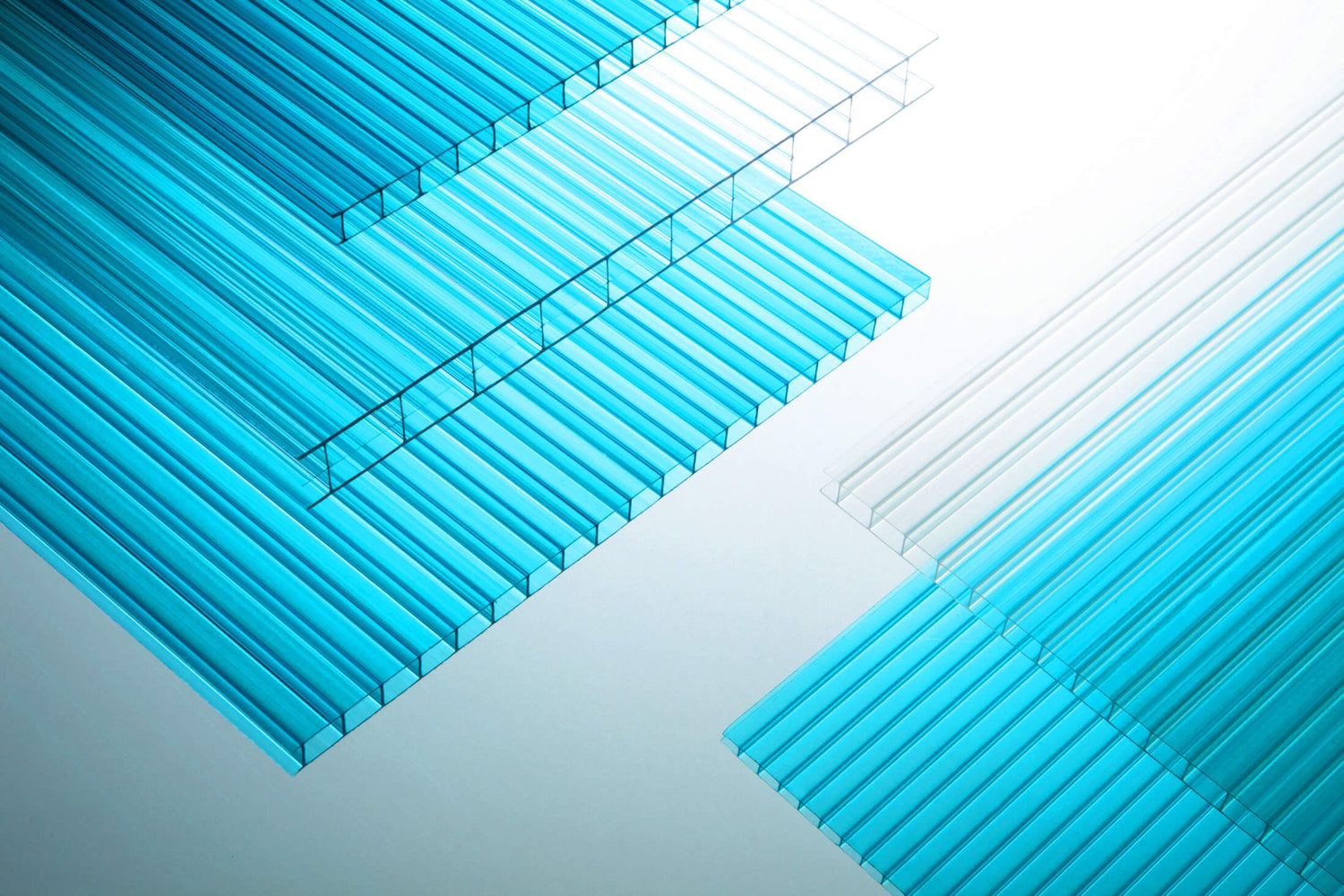Even though polycarbonates panels are inherently tough and can be used for virtually all applications, these properties can be improved to meet certain criteria for specific applications.
Solid Polycarbonate sheet
The solid polycarbonate sheet is compact in design. They have exceptional light transmission with up to more than 89% light transmission.This is due to the extreme clarity of these sheets.
However, the degree of light transmission can be modified by texturing or tinting its surface.They have a UV protection layer which protects it against the UV light which can cause the surface to turn yellow.
Impact strength;The solid structure of the polycarbonates gives them a higher impact strength than most plastics and other glazing materials.Their impact strength is 200 times greater than that of glass and 10 times tougher than that of a toughened glass.
Lightweight;It is one half the weight of glass (considering the same volume).This results into significant costs savings since the overall structure may not require additional reinforcement. In addition to this, it will also save on the freight costs.
Thermal insulation; Generally, the solid polycarbonates have a lower thermal conductivity which reduces the loss of thermal heat.
Building which have been constructed with these polycarbonates may not require additional air conditioning systems.
Flame resistance;They have a high ignition temperature of about 580°C.The solid polycarbonates have been rated B1.
There are several factors which distinguish the solid polycarbonate sheets from other polycarbonate sheets which are used in glazing application.They include:
- The construction; these polycarbonates have only one single layer as opposed to two or more layers which is a common scenario with the hollow polycarbonate products.
- Weight; even though they have a lightweight, they are heavier than the corflut polycarbonate sheets since they do not have air spaces within their structure.
- Thermal insulation; even though polycarbonate sheets are poor conductors of heat and electricity, the hollow polycarbonate sheets have superior insulation properties.This is because they trap air in between it the layers which act as additional insulator.
- Price; the solid polycarbonate sheets are more expensive than the hollow polycarbonate sheets.In the solid polycarbonate sheets, more of the polycarbonate resin is required to manufacture a sheet of the same size as the hollow polycarbonate sheets.
- Sound insulation; the solid polycarbonates offer better sound insulation properties than the hollow polycarbonates sheets.It is for this reason that they are used in applications which require sound proof sheets.
Twinwall polycarbonate sheet
This is the second category of polycarbonate sheets.These sheets are manufactured with some spaces in between the layers.
One distinct feature about hollow polycarbonate sheets is that they require small quantity of raw materials as compared to the solid sheets.
The hollow polycarbonate sheets are also referred to as cellular, channel, multi-wall or structural polycarbonate sheets.
They are referred to as cellular polycarbonate sheet due to internal structure of the sheets which as a lot of air spaces.The unique feature of these glazing products include:
- They have air spaces within the chamber which provide excellent thermal insulation.This is the reason why they are used in glazing applications where heat conservation is of essence.
- The dividing walls act as supportive structure which provide a strong structural rigidness and flexibility of the polycarbonate sheet.
The twin-wall polycarbonate sheets are used in applications where transparency and high impact strength are of importance.
Their excellent physical strength, mechanical and electric property explain why it is a perfect choice in decoration and building industry.
Polycarbonate twinwall sheets possess all the desirable physical and chemical properties of polycarbonate sheets such as high impact strength, light weight, light transmission,UV protection, easy installation, sound insulation, etc.
The most common types of hollow polycarbonate sheets include:
- The twin-wall polycarbonate sheets; these sheets are made up of two polycarbonate sheets with an air space and dividing walls between the walls.
- The triple wall polycarbonate sheets; they have three polycarbonate sheets which are separated with two layers of air spaces and dividing walls.
There those with four, five or six polycarbonate sheets.The number of walls and air space layers will depend on the desired U-value and R-value. The U-value is used to determine the effectiveness of a material to be used as an insulator while the R-value is the measure of thermal resistance. Ideally, the use of hollow polycarbonate sheets is designed to improve the insulation properties of the polycarbonate sheets.
The Multi-wall Polycarbonate Sheets
The internal structure of the hollow polycarbonate sheets vary greatly depending on the magnitude of strength the hollow polycarbonate manufacturer would wish to achieve. Some of the most common internal structure are:
Apart from the excellent thermal characteristics which the hollow polycarbonate sheets possess, other features include:
- Weight; they are not as heavy as the solid polycarbonate sheets.This reduces the shipping costs. Moreover, the overall structure will not require a lot of reinforcements which also reduces the overall construction cost.
- Price; they are cheaper than the solid polycarbonate sheets since the manufacturing process require less raw materials as compared to the solid polycarbonate sheets.
Choosing the desired hollow polycarbonate sheet is a challenging process, more so, one which should offer optimal light transmission and diffusion.
It is for this reason that every polycarbonate sheet comes with their own data sheet where buyers can assess all the physical and mechanical properties.
These sheets come in different tints and their surfaces can be modified just like the solid polycarbonate sheets. All sheets should come with a warranty, especially that which protects them from turning yellow prematurely.
Corrugated Polycarbonate sheet
The use of corrugated glazing materials is not a nascent technology.This technology has been used to manufacture a number of steel and iron roofing sheets.
The corrugated polycarbonate sheets have also gained popularity in the recent past due to the wide range of benefits they offer.
They have been designed to meet the specific manufacturing profile of the corrugated iron and steel sheets.Their corrugated nature makes them tough and strong to withstand high impact, especially when they are used in glazing applications.
Like other polycarbonate sheets and products, they possess all the desirable intrinsic features of polycarbonate resin.
Their surface and tints can be modified to alter certain features such as light transmission and light diffusion.Some of the most common tints include:
- The clear corrugated sheets which can transmit 90% of light.
- The Opal white corrugated sheets which can transmit up to 45% of light.
- The solar control silver which transmit about 20% of light.
- Solar grey which can transmit about 35% of light.
- Hunter grey and red brick which are known for minimal light transmission.
There are the custom made corrugated polycarbonate sheets which are mainly used by those companies and firms which would wish to have a completely unique glazing sheets.
Like other polycarbonate sheets which are used in the industrial and domestic applications, these corrugated sheets are protected against ultra-violet radiation which makes them to offer optimal performance for a very long period of time.
Advantages of corrugated polycarbonate sheets
Strength; the main idea of having the corrugated solid and hollow polycarbonate sheets is to add more mechanical and impact strength to these glazing sheets.
They are over 200 times stronger than other corrugated plastics. Furthermore, they can retain their mechanical strength within a wide range of temperature of between -40°C to 130°C.
This will reduce the maintenance cost and the guarantee safety of the overall structure.
Versatility; the corrugated sheets are rugged, thus, they can be used for virtually all glazing applications such as in skylight and greenhouse construction.
They can withstand adverse weather conditions such hailstorms, fluctuating temperature, etc.They are also flexible which makes the installation process easier and affordable.
Optical clarity; the modern corrugated sheet has been designed with additive which will ensure that the sheets retains its high degree of light transmission throughout its lifetime.
That is, for a clear corrugated sheet, it can maintain 90% of light transmission for close to 10 years.This is also a similar scenario when it comes to the opal white corrugated sheets.
Cost; unlike the corrugated iron sheets, the corrugated polycarbonate sheets have a lightweight.This save on the freight costs and the installation costs.
Aesthetic value; the corrugated nature of these sheets is appealing to the eye.This is one of the main reason why they are used to construct stadiums and buildings.The different tints give it a bold appearance.
Apparently, other features such as the multi-wall or textured surfaces are apparently being incorporated in the manufacturing process of corrugated sheet.
This will make it appealing to the eye and to serve quite a number of domestic and industrial applications.
We're happy to help you to buy the best product for you!



1 comment
أحمد محمد عبدالقوى
Dear sir
What’s choose for chemical factory UPVC sheet hollow or solid.
Dear sir
What’s choose for chemical factory UPVC sheet hollow or solid.